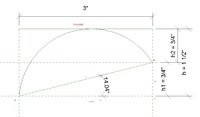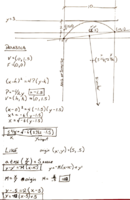You are using an out of date browser. It may not display this or other websites correctly.
You should upgrade or use an alternative browser.
You should upgrade or use an alternative browser.
Locate the center of the circle
- Thread starter gmb
- Start date
Dr.Peterson
Elite Member
- Joined
- Nov 12, 2017
- Messages
- 16,116
The standard way to find the center is to intersect the perpendicular bisectors of any two chords, of which there are two visible in the image. You could also use the line through the point of tangency perpendicular to the tangent, but that point is not accurately located.Been trying to figure this out for the better part of a week.
Given the top line is tangent to the arc segment and points A and B are known how do you find the center of the circle?
Or are you looking for a calculation based on the numbers shown, without using the drawing itself?
A calculation based solution is preferable as the product will be a parameter-driven radius derived from the changing of one or more of the defined measurementsThe standard way to find the center is to intersect the perpendicular bisectors of any two chords, of which there are two visible in the image. You could also use the line through the point of tangency perpendicular to the tangent, but that point is not accurately located.
Or are you looking for a calculation based on the numbers shown, without using the drawing itself?
Dr.Peterson
Elite Member
- Joined
- Nov 12, 2017
- Messages
- 16,116
Here's one approach you can take:
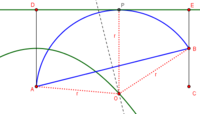
You're looking for the center, O. In order for it to pass through A and B, it must lie on the perpendicular bisector of AB (the broken black line), so that OA = OB = r. In order for it also to be tangent to DE, it must also be equidistant from A and DE (OA = OP = r), which is the definition of a parabola with focus A and directrix DE (the green curve). So O is the intersection of that line and that curve.

You're looking for the center, O. In order for it to pass through A and B, it must lie on the perpendicular bisector of AB (the broken black line), so that OA = OB = r. In order for it also to be tangent to DE, it must also be equidistant from A and DE (OA = OP = r), which is the definition of a parabola with focus A and directrix DE (the green curve). So O is the intersection of that line and that curve.
jonah2.0
Full Member
- Joined
- Apr 29, 2014
- Messages
- 535
Beer soaked diagram follows.
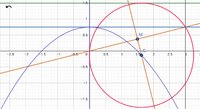
Here's one approach you can take:
View attachment 24375
You're looking for the center, O. In order for it to pass through A and B, it must lie on the perpendicular bisector of AB (the broken black line), so that OA = OB = r. In order for it also to be tangent to DE, it must also be equidistant from A and DE (OA = OP = r), which is the definition of a parabola with focus A and directrix DE (the green curve). So O is the intersection of that line and that curve.

Dr.Peterson
Elite Member
- Joined
- Nov 12, 2017
- Messages
- 16,116
What do you mean? The algebra isn't too hard, and there is a solution. What does "too many constraints" mean? (It's true that your OP has too many constraints, in the sense that the angle can be derived from the other information, so it can be ignored. But I don't think that's what you mean.)Thanks. Programing for the intersection of the parabola is just introducing just too many constraints to account for tho.
If you just mean you don't know how to find the equation of the parabola, we can help you with that. Or if the problem is elsewhere in the work, show that to us.
Thank You. I am using Autodesk REVIT to perform the calculations which will drive physical geometry. What I need is to be able to tell the geometry where the center lies. I do not seem to have a way within the program to translate the graphed intersection to x,y coordinates.
Dr.Peterson
Elite Member
- Joined
- Nov 12, 2017
- Messages
- 16,116
What I've been suggesting is that you do the algebra, not that you have your program do it. Have you tried solving to get a formula? If you have trouble with that, we can help.
I've been able to plot the points along the parabola via the equation x=sqrt(-12(y-3) and along the bisector via y-y1=-M(x-x1
and find the subsequent intersect via plotting, however, Is there a formula that can be used to predict where the two would meet?
and find the subsequent intersect via plotting, however, Is there a formula that can be used to predict where the two would meet?
Dr.Peterson
Elite Member
- Joined
- Nov 12, 2017
- Messages
- 16,116
Can you write the equation of the perpendicular bisector? You've mentioned the general formula, but you'll want to make it specific.
Then write the equation of the parabola given its focus and directrix; here are a couple references:
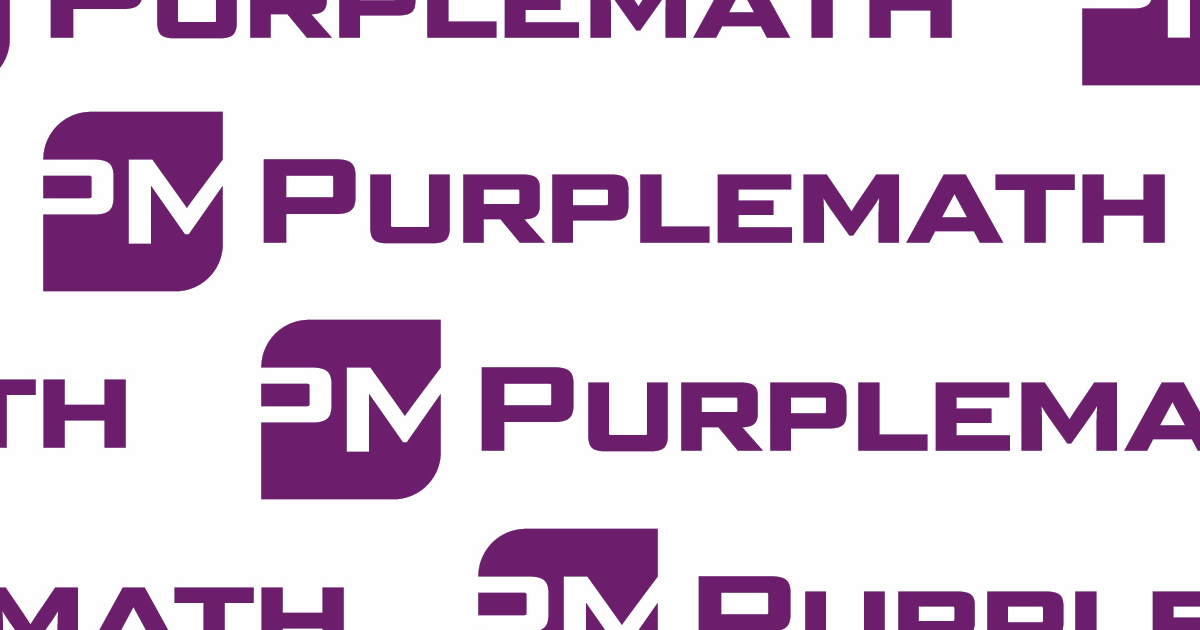
 www.purplemath.com
www.purplemath.com
The equation you wrote is similar to what I'd expect, but it should be satisfied by the vertex (0, 3/4), or whatever it is using your coordinate system.
Then solve the two equations. That will give you a formula for the point of intersection.
Then write the equation of the parabola given its focus and directrix; here are a couple references:

How do I get a parabola's info from its equation?
To begin extracting a parabola's information from its equation, first convert the equation (by completing the square) to obtain the vertex form.
The equation you wrote is similar to what I'd expect, but it should be satisfied by the vertex (0, 3/4), or whatever it is using your coordinate system.
Then solve the two equations. That will give you a formula for the point of intersection.
Dr.Peterson
Elite Member
- Joined
- Nov 12, 2017
- Messages
- 16,116
I wish you had done this with the same numbers as before so I could quickly check your results against my drawing to make sure the ideas are right. But I was able to adjust it easily enough, once I found all the changes you'd made. Your 5 3/8 and 3 11/32 are good approximations to the exact coordinates.
Your equation for the parabola is correct. Your equation for the perpendicular bisector is also correct.
So now you just need to solve the system of equations
One way to do this is to replace y in the first equation with its value from the second. Then you can use the quadratic formula. (You'll find that there are two solutions, but one would make the point of tangency be far to the right, rather than between A and B.
If you want a general formula for the coordinates, you can repeat the whole process with variables in place of the numbers that might vary.
Your equation for the parabola is correct. Your equation for the perpendicular bisector is also correct.
So now you just need to solve the system of equations
x^2 = -6(y - 1.5)
y = -10x + 50.5
One way to do this is to replace y in the first equation with its value from the second. Then you can use the quadratic formula. (You'll find that there are two solutions, but one would make the point of tangency be far to the right, rather than between A and B.
If you want a general formula for the coordinates, you can repeat the whole process with variables in place of the numbers that might vary.
Dr.Peterson
Elite Member
- Joined
- Nov 12, 2017
- Messages
- 16,116
Thank you so much! I finally got it. Took me longer to solve for y than anything else. dyslexic inputs, derp.
x^2=-6(-10x+50.5-1.5)
x=5.38293
y=(-1/6)x^2+1.5
y=-3.32932
To check that answer, we can get y from the second equation, since you used the first: y = -10(5.38293) + 50.5 = -3.3293.
So it looks good. (And, of course, it agrees with your measurements.)

